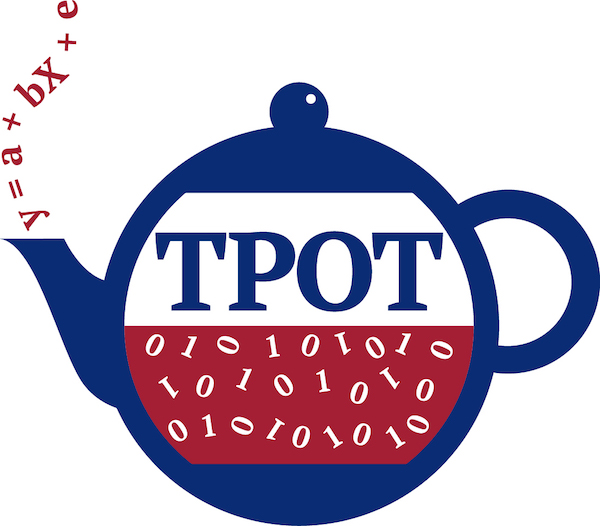
要尝试 TPOT2(alpha版),请前往此处!
TPOT2(alpha版),请前往此处!
TPOT代表树基管道优化工具(Tree-based Pipeline Optimization Tool)。将TPOT视为您的数据科学助手。TPOT是一个Python自动机器学习工具,使用遗传编程优化机器学习管道。

TPOT将自动化机器学习中最繁琐的部分,通过智能探索数千种可能的管道来找到最适合您数据的管道。

机器学习管道示例
一旦TPOT完成搜索(或者您不想再等待),它会为您提供找到的最佳管道的Python代码,以便您可以从那里继续调整管道。

TPOT是基于scikit-learn构建的,所以它生成的所有代码应该看起来很熟悉……如果您熟悉scikit-learn的话。
TPOT仍在积极开发中,我们鼓励您定期查看此存储库以获取更新。
有关TPOT的更多信息,请参阅项目文档。
许可证
请查看存储库许可证以了解TPOT的许可和使用信息。
通常,我们为TPOT授予许可,以使其尽可能广泛使用。
安装
我们在文档中维护TPOT安装说明。TPOT需要安装Python。
使用方法
TPOT可以在命令行或通过Python代码使用。
点击相应链接可在文档中找到更多关于TPOT使用的信息。
示例
分类
以下是使用手写数字光学识别数据集的最小工作示例。
from tpot import TPOTClassifier
from sklearn.datasets import load_digits
from sklearn.model_selection import train_test_split
digits = load_digits()
X_train, X_test, y_train, y_test = train_test_split(digits.data, digits.target,
train_size=0.75, test_size=0.25, random_state=42)
tpot = TPOTClassifier(generations=5, population_size=50, verbosity=2, random_state=42)
tpot.fit(X_train, y_train)
print(tpot.score(X_test, y_test))
tpot.export('tpot_digits_pipeline.py')
运行此代码应该会发现一个达到约98%测试准确率的管道,相应的Python代码将导出到tpot_digits_pipeline.py文件,看起来类似于以下内容:
import numpy as np
import pandas as pd
from sklearn.ensemble import RandomForestClassifier
from sklearn.linear_model import LogisticRegression
from sklearn.model_selection import train_test_split
from sklearn.pipeline import make_pipeline, make_union
from sklearn.preprocessing import PolynomialFeatures
from tpot.builtins import StackingEstimator
from tpot.export_utils import set_param_recursive
# 注意:确保在数据文件中将结果列标记为'target'
tpot_data = pd.read_csv('PATH/TO/DATA/FILE', sep='COLUMN_SEPARATOR', dtype=np.float64)
features = tpot_data.drop('target', axis=1)
training_features, testing_features, training_target, testing_target = \
train_test_split(features, tpot_data['target'], random_state=42)
# 训练集上的平均CV得分为:0.9799428471757372
exported_pipeline = make_pipeline(
PolynomialFeatures(degree=2, include_bias=False, interaction_only=False),
StackingEstimator(estimator=LogisticRegression(C=0.1, dual=False, penalty="l1")),
RandomForestClassifier(bootstrap=True, criterion="entropy", max_features=0.35000000000000003, min_samples_leaf=20, min_samples_split=19, n_estimators=100)
)
# 为导出管道中的所有步骤固定随机状态
set_param_recursive(exported_pipeline.steps, 'random_state', 42)
exported_pipeline.fit(training_features, training_target)
results = exported_pipeline.predict(testing_features)
回归
同样,TPOT也可以优化回归问题的管道。以下是使用波士顿房价实践数据集的最小工作示例。
from tpot import TPOTRegressor
from sklearn.datasets import load_boston
from sklearn.model_selection import train_test_split
housing = load_boston()
X_train, X_test, y_train, y_test = train_test_split(housing.data, housing.target,
train_size=0.75, test_size=0.25, random_state=42)
tpot = TPOTRegressor(generations=5, population_size=50, verbosity=2, random_state=42)
tpot.fit(X_train, y_train)
print(tpot.score(X_test, y_test))
tpot.export('tpot_boston_pipeline.py')
这应该会得到一个均方误差(MSE)约为12.77的管道,tpot_boston_pipeline.py中的Python代码应该类似于:
import numpy as np
import pandas as pd
from sklearn.ensemble import ExtraTreesRegressor
from sklearn.model_selection import train_test_split
from sklearn.pipeline import make_pipeline
from sklearn.preprocessing import PolynomialFeatures
from tpot.export_utils import set_param_recursive
# 注意:确保在数据文件中将结果列标记为'target'
tpot_data = pd.read_csv('PATH/TO/DATA/FILE', sep='COLUMN_SEPARATOR', dtype=np.float64)
features = tpot_data.drop('target', axis=1)
training_features, testing_features, training_target, testing_target = \
train_test_split(features, tpot_data['target'], random_state=42)
# 训练集上的平均CV得分为:-10.812040755234403
exported_pipeline = make_pipeline(
PolynomialFeatures(degree=2, include_bias=False, interaction_only=False),
ExtraTreesRegressor(bootstrap=False, max_features=0.5, min_samples_leaf=2, min_samples_split=3, n_estimators=100)
)
# 为导出管道中的所有步骤固定随机状态
set_param_recursive(exported_pipeline.steps, 'random_state', 42)
exported_pipeline.fit(training_features, training_target)
results = exported_pipeline.predict(testing_features)
查看文档获取更多示例和教程。
为TPOT贡献
欢迎您查看现有问题以寻找可处理的错误或改进。如果您有关于TPOT扩展的想法,请提交新问题,以便我们讨论。
在提交任何贡献之前,请查看我们的贡献指南。
遇到问题或对TPOT有疑问?
请查看现有的开放和已关闭的问题,看看您的问题是否已经得到处理。如果没有,请在此存储库上提交新问题,以便我们审查您的问题。
引用TPOT
如果您在科学出版物中使用TPOT,请考虑至少引用以下论文之一:
Trang T. Le, Weixuan Fu 和 Jason H. Moore (2020)。将基于树的自动机器学习扩展到生物医学大数据,并配备特征集选择器。生物信息学。36(1): 250-256。
BibTeX条目:
@article{le2020scaling,
title={Scaling tree-based automated machine learning to biomedical big data with a feature set selector},
author={Le, Trang T and Fu, Weixuan and Moore, Jason H},
journal={Bioinformatics},
volume={36},
number={1},
pages={250--256},
year={2020},
publisher={Oxford University Press}
}
Randal S. Olson, Ryan J. Urbanowicz, Peter C. Andrews, Nicole A. Lavender, La Creis Kidd, 和 Jason H. Moore (2016)。通过树形管道优化实现生物医学数据科学自动化。进化计算应用,页码 123-137。
BibTeX条目:
@inbook{Olson2016EvoBio,
author={Olson, Randal S. and Urbanowicz, Ryan J. and Andrews, Peter C. and Lavender, Nicole A. and Kidd, La Creis and Moore, Jason H.},
editor={Squillero, Giovanni and Burelli, Paolo},
chapter={Automating Biomedical Data Science Through Tree-Based Pipeline Optimization},
title={Applications of Evolutionary Computation: 19th European Conference, EvoApplications 2016, Porto, Portugal, March 30 -- April 1, 2016, Proceedings, Part I},
year={2016},
publisher={Springer International Publishing},
pages={123--137},
isbn={978-3-319-31204-0},
doi={10.1007/978-3-319-31204-0_9},
url={http://dx.doi.org/10.1007/978-3-319-31204-0_9}
}
Randal S. Olson, Nathan Bartley, Ryan J. Urbanowicz, 和 Jason H. Moore (2016)。评估用于自动化数据科学的树形管道优化工具。GECCO 2016会议论文集,页码 485-492。
BibTeX条目:
@inproceedings{OlsonGECCO2016,
author = {Olson, Randal S. and Bartley, Nathan and Urbanowicz, Ryan J. and Moore, Jason H.},
title = {Evaluation of a Tree-based Pipeline Optimization Tool for Automating Data Science},
booktitle = {Proceedings of the Genetic and Evolutionary Computation Conference 2016},
series = {GECCO '16},
year = {2016},
isbn = {978-1-4503-4206-3},
location = {Denver, Colorado, USA},
pages = {485--492},
numpages = {8},
url = {http://doi.acm.org/10.1145/2908812.2908918},
doi = {10.1145/2908812.2908918},
acmid = {2908918},
publisher = {ACM},
address = {New York, NY, USA},
}
或者,您可以直接使用以下DOI引用该存储库:
TPOT支持
TPOT由宾夕法尼亚大学计算遗传学实验室开发,并得到了美国国立卫生研究院R01 AI117694资助。我们非常感谢美国国立卫生研究院和宾夕法尼亚大学在项目开发过程中提供的支持。
TPOT的标志由Todd Newmuis设计,他慷慨地为这个项目无偿贡献了自己的时间。

 访问官网
访问官网 Github
Github 文档
文档 论文
论文










